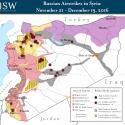 |
 |
Russian Airstrikes in Syria: November 21 - December 19, 2016
Dec 21, 2016 - Chris Kozak


Russia tempered its air operations across Northern Syria following the surrender of the last remaining opposition-held districts of Eastern Aleppo City on December 13, but only after playing a decisive military role in enabling this major battlefield victory for Syrian President Bashar al-Assad. Russia continued its campaign of airstrikes against the pocket of opposition-held districts southwest of the city center from December 7 – 12, intensifying its bombardment in the two days before Russia and Turkey brokered a surrender and local ceasefire agreement to evacuate remaining opposition fighters and civilians to Western Aleppo Province. Russia resumed its airstrikes in Aleppo City on December 14 after Iran spoiled the initial deal with additional last-minute demands for parallel evacuations from the besieged majority-Shi’a towns of Fu’ah and Kefraya in Idlib Province. Russia nonetheless slowed the tempo of its air operations in Aleppo and Idlib Provinces from December 13 – 19 in a likely attempt to preserve the evacuation deal and gain credibility as an impartial diplomatic broker. The eventual completion of the evacuation, however, will likely signal the start of a new phase in Russia’s air campaign in Northern Syria. Russia will likely resume its aggressive targeting of opposition-held terrain in Idlib Province under the guise of anti-terrorism operations against Jabhat Fatah al-Sham – the successor of Syrian Al-Qaeda affiliate Jabhat al-Nusra. This narrative may gain further traction as the remaining acceptable opposition forces evacuated from Aleppo City deepen their cooperation with Salafi-jihadist groups in Northern Syria in order to continue their insurgency against the Assad regime.
Russia also intensified its air operations against ISIS in Eastern Syria beginning on December 7 in a failed attempt to prevent the recapture of Palmyra in Eastern Homs Province by ISIS on December 11. Russia conducted heavy waves of airstrikes against ISIS on the outskirts of Palmyra from December 7 – 10 amidst an ongoing offensive by the group against outlying oil and natural gas fields. Although the air campaign forced ISIS to temporarily reverse its progress into Palmyra, poorly-trained pro-regime militiamen on the ground proved unable to hold the city – particularly given the withdrawal of local garrisons by Russia and Iran on or around December 7. In the wake of that defeat, Russia conducted punitive air operations against ISIS-held terrain in Eastern Syria on December 12, including the group’s stronghold in Ar-Raqqa City and a swathe of several villages in Eastern Hama Province allegedly targeted with chemical munitions. Russia will likely invest more heavily in the defense of the nearby T4 (Tiyas) Airbase in order to protect its main base of operations in Central Syria. Russia reportedly deployed special operations forces to T4 Airbase on December 13 amidst ongoing clashes with ISIS, reflecting the airfield’s critical importance as a launching point for helicopter gunships operated by Russia in Palmyra. The recapture of Palmyra highlights the inability of pro-regime forces to establish security across the entire country without sustained support from Russia and Iran, notwithstanding their recent success in Aleppo City. In the end, Russia and Syria prioritized the defeat of the opposition in Aleppo City over the defense of Palmyra from ISIS, ultimately enhancing the threat posed by Salafi-jihadist groups in both Northern and Eastern Syria.
The following graphic depicts ISW’s assessment of Russian airstrike locations based on reports from local Syrian activist networks, statements by Russian and Western officials, and documentation of Russian airstrikes through social media. This map represents locations targeted by Russia’s air campaign, rather than the number of individual strikes or sorties.
High-Confidence Reporting. ISW places high confidence in reports corroborated by documentation from opposition factions and activist networks on the ground in Syria deemed to be credible that demonstrate a number of key indicators of Russian airstrikes.
Low-Confidence Reporting. ISW places low confidence in reports corroborated only by multiple secondary sources, including from local Syrian activist networks deemed credible or Syrian state-run media.
By Jonathan Mautner